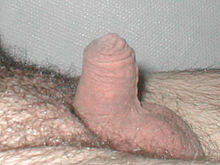- Micropenis
-
Micropenis Classification and external resources 
A flaccid micropenisICD-9 752.64 OMIM 607306 DiseasesDB 14839 eMedicine ped/1448 Micropenis is an unusually small penis. A common criterion is a dorsal (measured on top) erect penile length of at least 2.5 standard deviations smaller than the mean human penis size.[1] The condition is usually recognized shortly after birth. The term is most often used medically when the rest of the penis, scrotum, and perineum are without ambiguity, such as hypospadias.
Contents
Causes
 An erect micropenis.
An erect micropenis.
Of the abnormal conditions associated with micropenis, most are conditions of reduced prenatal androgen production or effect, such as abnormal testicular development (testicular dysgenesis, Klinefelter syndrome, Leydig cell hypoplasia), specific defects of testosterone or dihydrotestosterone synthesis (17,20-lyase deficiency, 5α-reductase deficiency), androgen insensitivity syndromes, inadequate pituitary stimulation (gonadotropin deficiency), and other forms of congenital hypogonadism. Micropenis can also occur as part of many genetic malformation syndromes that do not involve the sex chromosomes. It is sometimes a sign of congenital growth-hormone deficiency or congenital hypopituitarism. Several homeobox genes affect penis and digit size without detectable hormone abnormalities.
After evaluation to detect any of the conditions described above, micropenis can often be treated in infancy with injections of various hormones, such as human chorionic gonadotropin and testosterone.
Most eight- to fourteen-year-old boys referred for micropenis do not have the micropenis condition. Such concerns are usually explained by one of the following:
- a penis concealed in suprapubic fat (extra fat around the mons pubis).
- a large body and frame for which a prepubertal penis simply appears too small.
- delayed puberty with every reason to expect good future growth.
Treatment
Hormone treatment
Growth of the penis both before birth and during childhood and puberty is strongly influenced by testosterone and, to a lesser degree, growth hormone; but their value in the treatment of micropenis is mainly limited to conditions of hormone deficiency, such as hypopituitarism or hypogonadism.
Regardless of the cause of micropenis, if it is recognized in infancy, a brief course of testosterone is often prescribed[2] (usually no more than 3 months). This usually induces a small amount of growth, confirming the likelihood of further growth at puberty, but rarely achieves normal size. No additional testosterone is given during childhood, to avoid unwanted virilization and bone maturation. (There also is some evidence that premature administration of testosterone can lead to reduced penis size in the adult.)[3]
Testosterone treatment is resumed in adolescence only for boys with hypogonadism. Penile growth is completed at the end of puberty, similarly to the completion of height growth, and provision of extra testosterone to post-pubertal adults produces little or no further growth.
Surgery
Because hormone treatment rarely achieves average size, several surgical techniques similar to phalloplasty for penis enlargement have been devised and performed; but they are not generally considered successful enough to be widely adopted and are rarely performed in childhood.
In extreme cases of micropenis, there is barely any shaft, and the glans appears to sit almost on the pubic skin. From the 1960s until the late 1970s, it was common for sex reassignment and surgery to be recommended. This was especially likely if evidence suggested that response to additional testosterone and pubertal testosterone would be poor. If parents accepted, the boy would be reassigned and renamed as a girl, and surgery performed to remove the testes and construct an artificial vagina. This was based on three now questioned assumptions:
- gender identity and sex differences were solely a matter of social learning rather than biology.
- a male with a penis too small to put into a vagina could not find a satisfactory social and sexual place in society.
- a functionally acceptable vagina could be constructed surgically.
Johns Hopkins Hospital, the center most known for this approach, performed twelve such reassignments from 1960 to 1980, most notably[citation needed] that of David Reimer (whose penis was destroyed by a circumcision accident), overseen by Dr. John Money. By the mid 1990s, reassignment was less often offered, and all three premises had been challenged. Former subjects of such surgery, vocal about their dissatisfaction with adult outcome, played a large part in discouraging this practice. Sexual reassignment is rarely performed today for severe micropenis (although the question of raising the boy as a girl is sometimes still discussed.)[4] Much inaccurate or exaggerated folklore on this topic is available on the internet. (See "History of intersex surgery" for a fuller discussion.)
See also
References
- ^ Lee PA, Mazur T, Danish R, et al. (1980). "Micropenis. I. Criteria, etiologies and classification". The Johns Hopkins medical journal 146 (4): 156–63. PMID 7366061.
- ^ Ishii T, Sasaki G, Hasegawa T, Sato S, Matsuo N, Ogata T (2004). "Testosterone enanthate therapy is effective and independent of SRD5A2 and AR gene polymorphisms in boys with micropenis". J. Urol. 172 (1): 319–24. doi:10.1097/01.ju.0000129005.84831.1e. PMID 15201804.
- ^ McMahon DR, Kramer SA, Husmann DA (1995). "Micropenis: does early treatment with testosterone do more harm than good?". J. Urol. 154 (2 Pt 2): 825–9. doi:10.1016/S0022-5347(01)67175-1. PMID 7609189.
- ^ Calikoglu AS; Calikoglu, A (1999). "Should boys with micropenis be reared as girls?". J. Pediatr. 134 (5): 537–8. doi:10.1016/S0022-3476(99)70236-2. PMID 10228285.
External links
- Into the Hands of Babes, by Melissa Hendricks, Johns Hopkins Magazine
- Gender Self Reassignment in an XY Adolescent Female with Ambiguous Genitalia, from Pediatrics (PDF)
- Effect of penile size on nocturnal erections: evaluation with NPTR testing with men having micropenis from the International Journal of Impotence Research
Male congenital anomalies of the genitalia, including Intersex and DSD: (Q53–Q56 · 752.5–752.7) Internal OtherExternal OtherCategories:- Penis
- Congenital disorders of male genital organs
Wikimedia Foundation. 2010.

